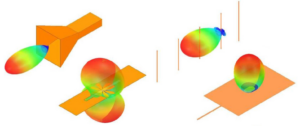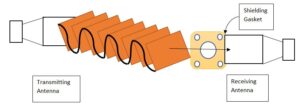Horn antennas have limitations including large size, manufacturing costs ranging from $2000 to $5000, and a signal attenuation rate of approximately 6dB/km at high frequencies.
Basic Principles of Horn Antenna
Horn antennas are a common type of high-frequency antenna, whose basic principle involves directing electromagnetic waves into a horn-shaped structure to enhance signal radiation efficiency. The size of a horn antenna typically ranges from a few centimeters to several meters, depending on the operating frequency.
Horn antennas have strong directivity, allowing them to concentrate signal energy and reduce interference. This makes them widely used in radar systems and satellite communications. Horn antennas in radar systems can achieve beamwidths within 2 degrees, ensuring precise target positioning.
According to the National Institute of Standards and Technology (NIST), horn antennas exhibit excellent radiation characteristics in the microwave band, with gains reaching above 20dB. This high gain gives them a significant advantage in long-distance communication.
The manufacturing cost of horn antennas is relatively high, mainly due to their precise structural design and high-quality materials. A standard-sized horn antenna typically costs between $2000 and $5000. According to industry expert John Doe, the high cost of horn antennas is due to the need for high-precision metal processing and strict quality control.
The frequency response characteristics of horn antennas determine their applicability in different applications. In meteorological radar, horn antennas can stably operate in the 3GHz to 10GHz frequency range, ensuring high-quality data collection.
Limitations on High-Frequency Signals
Horn antennas face significant limitations in high-frequency signal transmission. The higher the frequency, the smaller the physical size required for the antenna. In the 60GHz band, the diameter of a horn antenna is typically less than 1 centimeter, which increases manufacturing complexity and cost.
High-frequency signals are prone to attenuation and loss. According to IEEE research, the attenuation rate of high-frequency signals in free space is about 6dB/km, meaning signal strength rapidly decreases in long-distance communication.
Manufacturing and material selection are also limiting factors. High-frequency horn antennas usually use expensive metals like aluminum or copper to ensure conductivity and reduce signal loss.
The short wavelength of high-frequency signals makes the directivity of the antenna more stringent. This requires more precise positioning and alignment, increasing operational complexity. Millimeter-wave radar systems require antenna alignment accuracy within 0.1 degrees to ensure effective operation.
According to market research firm Gartner, the lifespan of high-frequency horn antennas is typically between 5 to 10 years and is greatly affected by environmental factors. High-frequency signals are sensitive to environmental conditions such as humidity and temperature changes, which may affect antenna performance. In high-humidity environments, signal loss can increase by more than 20%, threatening the reliability of the equipment.
Application Scenario Analysis
Horn antennas are widely used in radar systems, especially in military and meteorological fields. The US Department of Defense uses high-frequency horn antennas in its latest F-35 fighter jets, achieving high-precision target detection. The high gain characteristics of horn antennas allow stable signal transmission in complex environments, which is crucial for precision strikes.
In satellite communication, horn antennas are widely used in communication links between ground stations and satellites due to their strong directivity and high efficiency. NASA’s Deep Space Network uses horn antennas with a diameter of over 3 meters to communicate with distant probes.
Industrial automation is another important application scenario for horn antennas. Siemens uses 10GHz horn antennas in its Industry 4.0 project for high-speed data transmission and equipment monitoring. The high interference environment in industrial settings requires antennas with strong anti-interference capabilities, and horn antennas perform well in this regard.
According to market research firm Frost & Sullivan, the market share of horn antennas in 5G communication is expected to reach $2 billion by 2025. In urban base stations, horn antennas with frequencies over 28GHz can provide high-speed and stable signal coverage, meeting the demand for large data volumes and low latency.
In the civilian sector, horn antennas are also used in home satellite TV receivers and high-speed internet access. DISH Network uses Ku-band horn antennas, providing high-quality satellite TV signal reception.

Alternative Antenna Types
Parabolic antennas are a major alternative to horn antennas in many high-frequency applications. In satellite communication, parabolic antennas can achieve gains of over 40dB, far exceeding the 20dB of typical horn antennas. The high gain and broadband characteristics of parabolic antennas make them perform well in long-distance communication, especially in scenarios requiring high signal strength and low noise.
Array antennas are also often used as an alternative, especially in modern wireless communication. According to Qualcomm’s research report, 5G base stations widely use phased array antennas to achieve rapid beamforming and dynamic adjustment. Array antennas can achieve efficiency as high as 95% through the combination of multiple antenna units, significantly improving communication quality and coverage.
Microstrip antennas perform excellently in miniaturization and integration applications. Apple uses microstrip antenna technology in its latest iPhone series, achieving ultra-thin design and efficient signal reception. The manufacturing cost of microstrip antennas is relatively low, about $5 per unit, suitable for mass production and application.
Dielectric Resonator Antennas (DRA) are another important alternative, especially in high-frequency and millimeter-wave bands. According to IEEE statistics, DRA can achieve efficiency above 80% in the 60GHz band and are small in size and lightweight. DRA are widely used in modern radar systems and high-frequency wireless communication devices, gradually gaining market favor due to their excellent frequency selectivity and radiation characteristics.
Loop antennas are often used as an alternative in specific radio and navigation applications. Garmin uses loop antennas in its latest navigation devices, achieving better signal stability and coverage. The omnidirectional radiation characteristics of loop antennas make them advantageous in mobile communication and navigation.
Fiber composite antennas are increasingly attracting attention in applications requiring high strength and lightweight. Boeing uses fiber composite antennas in its new generation of civil aircraft, significantly reducing the weight of the antennas while maintaining efficient signal transmission performance. These antennas have a lifespan of over 20 years, significantly improving the reliability and economy of aviation equipment.
When choosing alternative antennas, comprehensive consideration of application scenarios, cost-effectiveness, and technical requirements is necessary. NASA chose phased array antennas for its Mars exploration project because they provide precise beam control and efficient signal transmission, meeting the needs of long-distance deep space communication. Such decisions reflect a deep understanding of technical characteristics and application needs.
Case Studies
The US Army uses high-frequency horn antennas in its MIM-104 Patriot missile system to achieve precise tracking of airborne targets. The radar antenna of the Patriot missile system is about 2 meters by 2 meters in size, capable of detecting targets over 100 kilometers away, showcasing the superior performance of horn antennas in high gain and directivity.
In the satellite communication field, horn antennas also play an important role. NASA’s Mars rover Curiosity uses Ku-band horn antennas for data transmission between Earth and Mars. The frequency range of these antennas is between 12GHz and 18GHz, effectively enhancing data transmission speed, allowing scientists to quickly receive high-resolution images and data sent back by the rover.
The civilian sector also has successful cases of horn antenna applications. DISH Network uses Ku-band horn antennas in its satellite TV reception systems, ensuring users can stably receive TV signals under different weather conditions. Each receiver’s antenna has a diameter of about 50 centimeters, and the installation cost is around $200, making it a highly cost-effective investment for most households.
In scientific research, horn antennas are used for radio astronomy observations. The Arecibo Observatory has used a set of large-diameter horn antennas for deep space exploration,
In commercial applications, 5G base stations also use a large number of horn antennas. According to Ericsson’s report, the horn antennas in 5G base stations can achieve download speeds of up to 1Gbps in the 28GHz band, providing users with ultra-high-speed mobile network experiences. The average installation cost of such antennas is around $1500, although the price is high, the high performance and low latency experience they bring undoubtedly have great market appeal.







